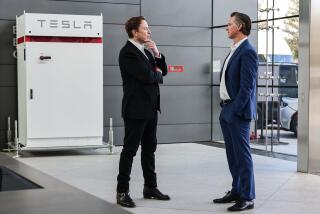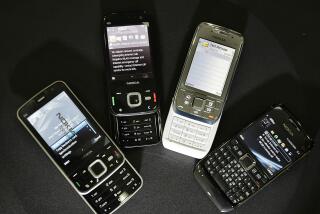The Place That Tech Forgot
- Share via
BERKELEY HEIGHTS, N.J. — Harriet Donnelly is a digital nomad. She lives in this New Jersey suburb and heads Technovative, a thriving high-tech marketing firm. But her business has no physical office. Each of her company’s 100 employees or regular contractors--dispersed across the nation--works independently from home or hotel room. Most have never met, except online or in conference calls.
Donnelly, 44, works upward of 80 hours in a weekly marathon. She travels half the time and will log 15,000 flying miles a month visiting clients. She has grown wealthy managing conferences, creating ads, logos, technical publications and Web sites for AT&T; and Lucent Technologies, as well as a parade of “dot-coms.”
Clients keep offices for her in Palo Alto, San Francisco, San Diego and St. Louis. But wherever she may be, Donnelly is never out of touch--electronically linked to clients, loved ones and employees 365 days a year.
“I work from that,” she said, pointing to a briefcase bulging with electronic essentials--laptop and hand-held computers and an Internet cell phone--that support her constant stream of calls, e-mails and instant messages. “The place doesn’t matter.”
Social scientists wonder whether this relentless electronic communications lifestyle may be eroding the feelings of belonging and attachment that many consider cornerstones of happiness and community, and promoting a disorientation and rootlessness that can spread from work to home life.
“Technology, by erasing distance, is erasing also our sense of place,” said Harvard University professor Robert D. Putnam, author of groundbreaking research on community and isolation in modern American life. “Face-to-face connections are very important in many ways, including for physical and psychological health.”
Paul Saffo, a director of the research group Institute for the Future, says living in a technology-driven, communications-rich world always poses a peril for those who can’t find the “off” button and “risk entering the electronic squirrel cage.”
Some have tried to put up real and psychological barriers to avoid that problem and keep their sense of place intact.
Few would consider Donnelly’s luxurious home--with big-screen TVs and a sprawling backyard adjoining a wooded hillside--a cage. She lives there with her boisterous 6-year-old, Sean, husband Chip, live-in nanny and three dogs.
Yet she often shuns creature comforts. Donnelly splits the vast majority of her waking hours among hotel rooms, client offices, planes and a cramped, cluttered home study--its walls adorned only by a signed poster of Pittsburgh Steeler football star Jerome Bettis, a participant in one of her marketing projects.
She also has adopted habits to break down the isolation that her lifestyle could lead to. When she works at home, the TV is always on, tuned to soaps or talk shows that offer the reassuring illusion of a human presence.
She spends a few hours each Saturday and Sunday with her son. She says that traveling half of the time keeps her 20-year marriage fresh. “If you think about it, we’ve been married 10 years,” she jokes.
With little time for friends, Donnelly has developed an extended family--Ben, the New Jersey airport limousine driver who has known Sean since birth, makes himself comfortable in her living room. They exchange gifts at Christmas. She is close to workers in hotels, including a Westin near the San Francisco airport where she has stayed hundreds of times. Donnelly spent most of her pregnancy in that hotel; the staff bought her a gift when Sean was born.
For many, such adaptations help make sense of an increasingly mobile business world in which distance may be seen as irrelevant.
“Location has become less important,” said Jeff Cable, 37, marketing chief for Magellan Corp., a Santa Clara maker of satellite navigation aids for everyone from hikers to the U.S. Department of Defense. Cable, who keeps 1,000 numbers stored in the cell phone clipped eternally to his belt, can always be reached. “Very few people ask where are you, unless you have a bad connection. If people can reach you, they don’t care anymore.”
Recently, Cable flew to Santiago, Chile, then to Berlin on business. He may seem elusive, but he’s never more than a cell call away. He can be reached in Santiago by dialing the same 408 area code used at his office in Santa Clara.
Another digital drifter, Neil Daswani, 26, travels only a few days a month, yet even more than Donnelly or Cable, he’s at war with the constraints of the physical world. Daswani manages a team of engineers for Yodlee Inc.--a Silicon Valley Internet firm that provides one-stop access for consumers to credit card and banking records, e-mail, travel itineraries and other personal data.
At work, his square, off-white cubicle fits within scores of identical spaces. The walls of his disheveled work space are nearly blank--why decorate when he’s perpetually on the move? As for the company’s 150 employees, they all have regular office phones but don’t bother to learn anyone’s extension--they simply call each other’s cell phones.
Daswani’s sparsely furnished apartment in Foster City, a bland suburb that has soared in population to feed Silicon Valley’s insatiable growth, is “just a place to sleep,” he said. He recently acquired a bed for that purpose. For most of the last year, Daswani slept on a pile of comforters on the floor because buying a bed was too much of a hassle.
He has no home phone. Why waste money? Everyone knows his cellular number and, with a typical workday lasting from 10 a.m. to 10 p.m. or later, often seven days a week, he’d rarely be there to answer.
Daswani allows that this pace can’t go on forever. If he finds a serious girlfriend, “I’d have to do some restructuring of priorities,” he said.
He uses mobility tools to constantly push the limits of accessibility. His favorite is a $400 BlackBerry text-message pager to which e-mail from his office computer is forwarded when he’s away from his desk. Some 250 messages stream in daily from contacts and co-workers, alerting him with a vibration every time a new one arrives. His responses rapidly follow, tapped out on the device’s tiny keypad.
“I can’t live without it,” Daswani said. Returning from a recent business trip, for example, “between the time the plane started landing and the time I reached the gate, I had answered at least five e-mails.”
Such electronically linked addicts may seem to run the risk of fragmenting human contact among a multitude of remote communications--threatening the primacy of place. Yet they are not necessarily doomed to social isolation.
Oft-maligned cell-phone junkies loudly discuss meeting plans, doctor appointments or even love affairs while in line at a Blockbuster video store. They’ve tuned out the immediate environment--but replaced it with “networked individualism,” in which they are constantly in touch with friends, loved ones or colleagues, said Barry Wellman, a sociologist at the University of Toronto.
Nor do obsessive electronic communicators view in-person contact as an anachronism. Daswani’s cell-phone and pager addiction allows him to see people without missing a single message or call.
Yet, social scientists say, it’s hard to blame technology alone for an increasingly transient and independent culture.
Consider that the average American has moved every few years--for decades. Meanwhile, suburban sprawl, chain stores and malls have helped dissipate the intimacy and character of communities. Since the conglomerate boom of the 1960s, prideful institutions of local prestige and control have been passing into the hands of absentee owners--with a noticeable impact on civic pride and identity. And a burgeoning contingent work force, including contractors, temporaries and the self-employed, now account for 30% of total employment, making the United States a nation of free agents.
Yet, just as the Internet has been adopted rapidly, plummeting costs are quickly making mobile devices ubiquitous. And the builders of a new generation of phones, pagers and hand-held computers with Web surfing and e-mail features are working feverishly to attract new users.
These digital mobility devices are sold on the premise that they promote “flexibility,” but they can also produce a disorientation in values. For many, a trip to the great outdoors is an escape from modern life; not for Neil Daswani.
“Even when I went rafting a couple of weeks ago, my cell phone came with me,” Daswani said. “Because I can be tied into what’s going on in the office without being in the office, I’ll take liberties. I’ll take a one-hour lunch.”
His work ethic may seem extreme. But Daswani is typical of Silicon Valley, something the purveyors of always-on, cell-phone-packing, page-me, digitally transient lifestyles try to exploit.
“By the late ‘90s, the drumbeat for flexibility and self-invention had gone too far, not only because it blotted out the merits of place,” writes historian William Leach, author of “Country of Exiles,” which looks at America’s deteriorating sense of place. “It failed to address how few Americans could really invent themselves and to what degree their ‘mobility’ and ‘flexibility’ had nothing to do with their own free will.”
For example, the immediacy of paging seems to imprint a sense of urgency on most of Daswani’s 250 daily e-mails, even when many are inevitably trivial.
“Because everyone is as reachable as they are, and things have become so instantaneous--if you look at Silicon Valley, the stress levels . . . have gotten way out of hand,” conceded Cable. “If someone can’t get ahold of you immediately, no matter where you are, it frustrates them.”
For Cable, this is all taken in stride. But some social scientists would call this “messaging harassment.” A recent study sponsored by Pitney Bowes, a vendor of messaging technologies, found that heavy users of mobile devices report significantly greater feelings of distraction and overload from the volume of messages they receive than do other workers.
Yet for those like Harriet Donnelly--who never takes a vacation without her computer and cell phone--such devices support lives in which California and New Jersey, work and home, day and night, no longer seem to have distinct borders.
Her work is the constant, Donnelly said. “So what’s the difference? On the road, it’s exactly what I do at home. . . . It’s hard, but it’s good.”






